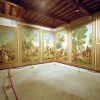- Accede I
- Regístrate I
- carrito
Museo de la Catedral
El Tesoro y Archivo de la Basílica jacobea comienza con el "Descubrimiento" de la Tumba del Apóstol, en 'Arcis Marmóricis', en la vieja 'Asseconia', actual Compostela, heredera de la Sede episcopal de Iria Flavia.
A la secular riqueza cultural, artística y documental, han venido a unirse los resultados de las excavaciones realizadas a finales del s. XIX y durante el XX, abarcando los largos siglos I al XI del "Locus Sancti Iacobi": el lugar famoso donde está enterrado Santiago el Mayor, discípulo predilecto de Cristo juntamente con su hermano Juan, apóstol y evangelista.
El Museo fue fundado en 1930 y en él se recogen las huellas de la extraordinaria historia del Santuario, que custodia la 'Tumba del Apóstol'. Es también 'Memoria de la Peregrinación' con una grata secuencia de piezas en el Tesoro.
Actualmente, en el recorrido del Museo se incluyen tres zonas con acceso independiente, todas ellas situadas en distintas dependencias de la Catedral compostelana, lo que permite un conocimiento completo de la historia e importancia artística de un centro culto-cultural fundamental para la humanidad.
Cripta del Pórtico de la Gloria
Situada bajo las escalinatas de la fachada del Obradoiro, fue construida por el Maestro Mateo dentro del completo programa iconográfico desarrollado en el Pórtico, salvando, así, el importante desnivel de la Catedral con la Plaza del Obradoiro; de lo que dan cumplida referencia los paneles existentes. Así mismo, se exponen obras escultóricas y la reconstrucción de los instrumentos del Pórtico de la Gloria.
Espacio Sacro Capilla de Reliquias-Panteón Real y Tesoro
En un lateral de la Catedral compostelana, se encuentra este espacio que, recientemente, se ha comunicado con el Claustro mediante la reapertura de la conocida como "Puerta de Fonseca". En la Capilla de Reliquias-Panteón Real se encuentran los sepulcros de Reyes de Galicia y sus familiares, así como el Retablo de Reliquias, con importantes piezas de orfebrería.
En el Tesoro se encuentran colecciones de orfebrería, elementos litúrgicos, marfil, cristal, etc.; mereciendo ser destacada la Custodia Procesional, obra de Antonio de Arfe.
Espacios del claustro
Ocupan cuatro plantas del lienzo occidental del Claustro catedralicio, con acceso por un lateral de la fachada del Obradoiro.
Se realiza un completo recorrido por la historia y testimonios artísticos de la Catedral, desde las primeras basílicas y los restos arqueológicos, el Románico, la obra del Maestro Mateo, con la reconstrucción del Coro Pétreo de la Catedral; la escultura en la Catedral entre los siglos XIII y XVIII, recorrido por el Claustro Manierista, Biblioteca, donde se expone el Botafumeiro, y Sala Capitular, terminando en la planta superior con la gran colección de tapices, que incluye una sala dedicada a Goya y la impresionante balconada que domina la Plaza del Obradoiro y las calles del Santiago histórico.
Espacio diivulgativo del Pórtico de la Gloria
Desde enero de 2015, la Fundación Barrié y la Fundación Catedral de Santiago promueven el nuevo Espacio Divulgativo del Pórtico de la Gloria en la Sala de Armas del Pazo de Xelmírez. Este espacio permanente aborda la historia, iconografía y el programa de restauración de la gran obra del maestro Mateo. Aplicaciones interactivas, fotografías de gran formato y paneles explicativos exponen el alto grado de deterioro y la urgencia de intervención, así como los trabajos desarrollados entre 2008 y 2012 por equipos multidisciplinares de expertos de Alemania, Italia y España.

























